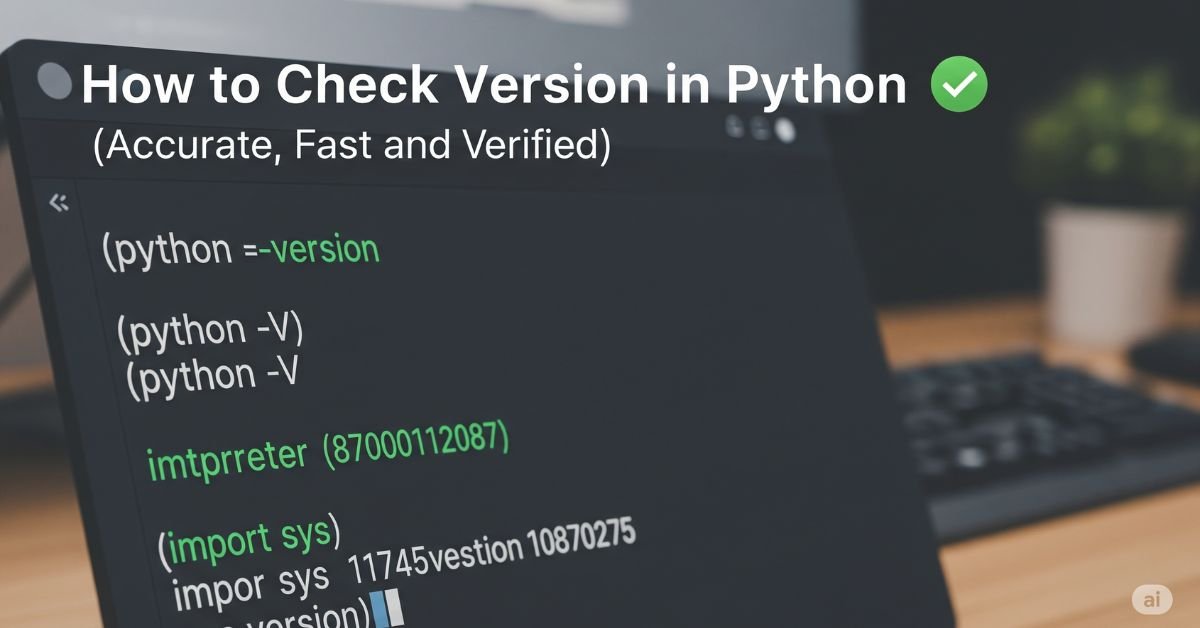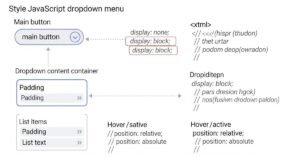Knowing how to check versions in Python is a must for writing clean and compatible code. Some tools only work with specific versions. Others break if your Python is outdated. In this article, you’ll learn how to check versions in Python (Accurate, Fast, and Verified) using easy and tested methods.
Whatever you need to code, debug, or initialize a project, this guide will assist you in obtaining the Python version information you require—quickly, clearly, and without confusion. Let’s explore the best practices and actual solutions employed by programmers on a daily basis..
Why Python Version Matters
Different versions of Python come with different features. Python 3.11 is faster than 3.7. Python 2 is outdated and no longer supported. If your code works in one version but fails in another, the version is likely the reason.
Checking the Python version is important for working with packages like NumPy, Django, or Flask. These libraries often require a minimum Python version. When things go wrong, the first thing you should check is your Python version.
Read More About : How to Web Scrape a Table in Python
Check Python Version from the Command Line
To check the Python version from your terminal, type python –version or python3 –version. You’ll see something like Python 3.11.6. This works on most systems. If you’re on Windows, py -V is the go-to command.
If you want more info from the terminal, run this: python -c “import sys; print(sys.version)”.
It gives you the full version, build date, and compiler. This is handy when reporting bugs or checking compatibility.
Check Python Version Inside a Script
When you’re writing a Python script, checking the version from inside the code can be helpful. It’s useful when your script needs to behave differently based on the version.
Use this line in your script:import sys; print(sys.version)This prints the full version string.
If you want structured data, use sys.version_info. This lets you check if you’re running at least Python 3.10 like this:if sys.version_info >= (3, 10): print(“Good to go!”)
Check Installed Package Versions in Python
The Python version is one thing. But your script may also depend on package versions. You can check installed packages by running pip list or pip show pandas.
To check package versions in code, use importlib.metadata (Python 3.8+):
from importlib.metadata import version; print(version(“requests”))On older versions, you can use: import pkg_resources; print(pkg_resources.get_distribution(“flask”).version)These methods help when debugging or making sure all your dependencies are correct.
Use the Platform Module as an Alternative
The platform module is another way to check Python’s version. It’s simple and gives readable results.Use this in your script: import platform; print(platform.python_version())
This gives you a clean string like “3.11.6”. You can also use
platform.python_implementation() to check if you’re using CPython, PyPy, or something else. This can help if you’re running Python on special systems or in cloud environments.
How to Check All Installed Python Versions
Sometimes, your machine has more than one Python version. This can cause confusion, especially if you install tools that expect a different version.
On Windows, type py -0p to see all installed versions and their paths. On Linux or macOS, try which python, which python3, or ls /usr/bin/python*.
Here’s a table with examples
| OS | Command | Output Example |
| Windows | py -0p | List of Python paths |
| macOS | ls /usr/local/bin/ | Multiple python binaries |
| Linux | which python3 | Shows active version path |
Best Practices for Python Version Checking
Never hardcode your version checks as strings. For example, don’t write if sys.version == “3.11.6”. That will break when even a minor update rolls out. Use version tuples instead.Also, always check the version at the start of your script if your code needs a minimum version.
This saves time and prevents bugs before they happen.For production environments, include version checks in your deployment scripts or CI/CD pipelines. It ensures that your code only runs where it’s supposed to.
Python Version Checking Met
| Method | Best For | Output Type |
| python –version | Quick terminal check | String |
| sys.version | Full details and debugging | String |
| sys.version_info | Version comparison in logic | Tuple |
| platform.python_version() | Clean readable output | String |
| pip show <package> | Package version checking | String |
Check Python Version as a Tuple
Sometimes, you need full control over version details. A version string is great, but not always ideal for comparison. This is where the version tuple helps. Python lets you get a version in tuple form using the sys.version_info. It’s a handy built-in object.
The output gives major, minor, micro, release level, and serial. For example, if your Python version is 3.10.4, the tuple will show (3, 10, 4, ‘final’, 0). You can even compare versions easily using this. Want to make sure you’re using Python 3.8 or newer? Just write a simple if condition to compare the version tuple.
Real-World Case Study: Version Conflicts in Production
Let’s talk about a real-life case that shows why version checking matters. A developer deployed a Flask web app to a server that had Python 3.6. Locally, they had tested everything on Python 3.10. The code used match-case statements, which were only introduced in Python 3.10.
If the developer had used a simple version check like this:pythonCopyEditimport sys if sys.version_info < (3, 10): raise Exception(“Python 3.10 or higher is required.”)That crash would have been avoided.
Using Python in Virtual Environments
A virtual environment is like a sandbox. It keeps your Python version and packages separate from the system. But it can also make version checking tricky if you forget which environment you’re in.
To avoid confusion, activate the environment first. Then check the version using python –version or run import sys; print(sys.executable) to see the path. This tells you whether you’re using the virtual environment or not.
Here’s a simple table comparing version paths:
| Context | Method | Output Example |
| Global Python | sys.executable | /usr/bin/python3 |
| Virtual Environment | sys.executable | /myproject/venv/bin/python |
Automating Python Version Checks in CI/CD
When you deploy code to servers or push it to production, it’s smart to automate version checking. This ensures that your build scripts or CI pipelines don’t fail unexpectedly.
For example, in GitHub Actions, you can add this:yamlCopyEdit- name: Check Python version run: python –versionIn Jenkins or GitLab CI, do the same by adding the version check as the first step. That way, you won’t waste time running full tests on the wrong Python version.
You will like : How Hard Is It to Learn SQL?
How Python Versions Impact Package Behavior
It’s not just your code that depends on the Python version—packages behave differently too. For instance, pandas added some breaking changes between versions. If you’re using a function that was removed in a newer version, you might get weird errors.
Here’s an example. In pandas 2.0, the DataFrame.append() method was removed. If you’re on Python 3.11 and install the latest pandas, older code using .append() will crash.
Why Some Systems Have Python 2 and Python 3
You might wonder why your computer has two versions of Python. This happens a lot on Linux and macOS. That’s because older tools or scripts might still rely on Python 2. Many operating systems used it as the default for years.
Python 2 reached its end of life in 2020. But some scripts and software still haven’t been updated. That’s why Python 2 is still hanging around in places.To be safe, always use python3 when starting a new project. If you’re not sure what version runs by default, run:bashCopyEditpython –version python3 –version
Staying Updated Without Breaking Your Code
It’s good to update Python, but don’t do it blindly. Always test your scripts on the new version first. Some changes break old code—even if the update sounds small.
Use virtual environments to test updates without affecting your main system. For Linux and macOS users, tools like pyenv let you install and switch between multiple Python versions safely.Here’s how to list all available versions:bashCopyEditpyenv install –listYou can then install the one you need and run:bashCopyEditpyenv global 3.11.6
FAQ”s
How do I check the Python version in the Jupyter Notebook?
You can type !python –version or run import sys; print(sys.version) inside a code cell.
Can I check the Python version without a script?
Yes. Just open your terminal or command prompt and run python –version.
What’s the difference between sys.version and platform.python_version()?
sys.version gives more detailed info, while platform.python_version() is cleaner and simpler.
How to check the Python version inside a virtual environment?
Activate the virtual environment and then use python –version or sys.version.
Why do I have multiple Python versions?
Some systems ship with Python 2 and Python 3. Developers often install different versions for different tools or apps.
Conclusion
Now you’ve learned how to check versions in Python (Accurate, Fast, and Verified) using many reliable methods. From command-line tools to in-script solutions, you now have complete control. This knowledge helps you debug, deploy, and run Python projects with confidence. Always check before you code, and you’ll avoid most version-related headaches.




